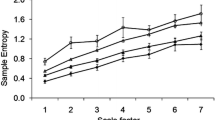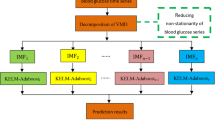Abstract
Glucose variability provides detailed information on glucose control and fluctuation. The aim of this study is to investigate the glucose variability by multi-scale analysis approach on 72-h glucose series captured by continuous glucose monitoring system (CGMS), gaining insights into the variability and complexity of the glucose time series data. Ninety-eight type 2 DM patients participated in this study, and 72-h glucose series from each subject were recorded by CGMS. Subjects were divided into two subgroups according to the mean amplitude of glycemic excursions (MAGE) value threshold at 3.9 based on Chinese standard. In this study, we applied two types of multiple scales analysis methods on glucose time series: ensemble empirical mode decomposition (EEMD) and refined composite multi-scale entropy (RCMSE). With EEMD, glucose series was decomposed into several intrinsic mode function (IMF), and glucose variability was examined on multiple time scales with periods ranging from 0.5 to 12 h. With RCMSE, complexity of the structure of glucose series was quantified at each time scale ranging from 5 to 30 min. Subgroup with higher MAGE value (>3.9) presented higher glycemic baseline and variability. There were significant differences in glycemic variability on IMFs3–5 between subgroups with MAGE>3.9 and MAGE < = 3.9 (p<0.001), but no significant differences in variability on IMFs1–2. The complexity of glucose series quantified by RCMSE showed statistically difference on each time scale from 5 to 30 min between subgroups (p<0.05). Glucose series from subjects with higher MAGE value represented higher variability but lower complexity on multiple time scales. Compared with traditional matrices measuring the glucose variability, approaches of EEMD and RCMSE can quantify the dynamic glycemic fluctuation in multiple time scales and provide us more detailed information on glycemic variability and complexity.




Similar content being viewed by others
References
Zhang X, Xu X, Jiao X et al (2013) The effects of glucose fluctuation on the severity of coronary artery disease in type 2 diabetes mellitus. J Diabetes Res 2013:347–353
Monnier L, Colette C (2008) Glycemic variability: should we and can we prevent it. Diabetes Care 31(Suppl 2):S150–S154
Sacks DB, Bruns DE, Goldstein DE, Maclaren NK, McDonald JM, Parrott M (2002) Guidelines and recommendations for laboratory analysis in the diagnosis and management of diabetes mellitus. Clin Chem 48:436–472
Kohnert KD, Heinke P, Vogt L et al (2015) Utility of different glycemic control metrics for optimizing management of diabetes. World J Diabetes 6:17–29
Kilpatrick ES, Rigby AS, Atkin SL (2008) A1C variability and the risk of microvascular complications in type 1 diabetes. Diabetes Care 31:2198–2202
Louis M, Emilie M, Christine G et al (2006) Activation of oxidative stress by acute glucose fluctuations compared with sustained chronic hyperglycemia in patients with type 2 diabetes. Jama-J Am Med Assoc 295:1681–1687
Strachan MWJ, Reynolds RM, Marioni RE et al (2011) Cognitive function, dementia and type 2 diabetes mellitus in the elderly. Nat Rev Endocrinol 7(2):108–114
Strachan MW, Price JF, Frier BM (2008) Diabetes, cognitive impairment, and dementia. BMJ 336(7634):6
Strachan MW, Reynolds RM, Frier BM et al (2008) The relationship between type 2 diabetes and dementia. Br Med Bull 88(1):131
Williamson JD, Miller ME, Bryan RN et al (2007) The action to control cardiovascular risk in diabetes memory in diabetes study (ACCORD-MIND): rationale, design, and methods. Am J Cardiol 99(12):S112–S122
Cukiermanyaffe T, Gerstein HC, Williamson JD et al (2009) Relationship between baseline glycemic control and cognitive function in individuals with type 2 diabetes and other cardiovascular risk factors: the action to control cardiovascular risk in diabetes-memory in diabetes (ACCORD-MIND) trial. Diabetes Care 32(2):221–226
Smith-Palmer J, Brändle M, Trevisan R et al (2014) Assessment of the association between glycemic variability and diabetes-related complications in type 1 and type 2 diabetes. Diabetes Res Clin Pr 105:273–284
Jung H S (2015) Clinical implications of glucose variability: chronic complications of diabetes.[J]. Endocrinol Metab 30:167–74
Zhang XG, Zhang YQ, Zhang DK et al (2014) Relationship between blood glucose fluctuation and macrovascular endothelial dysfunction in type 2 diabetic patients with coronary heart disease. Eur Rev Med Pharmaco 18:3593–3600
Jiao XM, Zhang XG, Xu XU et al (2014) Blood glucose fluctuation aggravates lower extremity vascular disease in type 2 diabetes. Eur Rev Med Pharmaco 18:2025–2030
Xu F, Zhao LH, Su JB et al (2014) The relationship between glycemic variability and diabetic peripheral neuropathy in type 2 diabetes with well-controlled HbA1c. Diabetol Metab Syndr 6:1–7
Richard B, Gabriel A, Harald H et al (2012) Glycemic variability and glucose complexity in critically ill patients: a retrospective analysis of continuous glucose monitoring data. Crit Care 16:1–9
Costa MD, Henriques T, Munshi MN et al (2014) Dynamical glucometry: use of multiscale entropy analysis in diabetes. Chaos 24:146–149
García ML, González LB, Furquet GL et al (2016) Study of glycemic variability through time series analyses (Detrended fluctuation analysis and Poincaré plot) in children and adolescents with type 1 diabetes. Diabetes Technol Ther 18(11):719
Breton MD, Shields DP, Kovatchev BP (2008) Optimum subcutaneous glucose sampling and Fourier analysis of continuous glucose monitors. J Diabetes Sci Technol 2(3):495–500
Miller M, Ph D, Strange P (2007) Use of Fourier models for analysis and interpretation of continuous glucose monitoring glucose profiles. J Diabetes Sci Technol 1:630–638
Scheen AJ, Sturis J, Polonsky KS et al (1996) Alterations in the ultradian oscillations of insulin secretion and plasma glucose in aging. Diabetologia 39:564–572
Veldhuis JD, Iranmanesh A, Lizarralde G et al (1989) Amplitude modulation of a burstlike mode of cortisol secretion subserves the circadian glucocorticoid rhythm. Am J Phys 257:E5–E14
Antoniutti S (2003) preparazione e reattività di diazoalcano complessi di rutenio stabilizzati da legante scorpionato. Diabetes Care 26:168–171
Simon C, Brandenberger G (2002) Ultradian oscillations of insulin secretion in humans. Diabetes 51(Suppl 1):S258–S261
Simon C, Brandenberger G, Follenius M et al (1991) Alteration in the temporal organisation of insulin secretion in type 2 (non-insulin-dependent) diabetic patients under continuous enteral nutrition. Diabetologia 34:435–440
Cauter EV, Polonsky KS, Scheen AJ (1997) Roles of circadian rhythmicity and sleep in human glucose regulation. Endocr Rev 18:716–738
Kolopp M, Bicakova-Rocher A, Reinberg A et al (1986) Ultradian, circadian and circannual rhythms of blood glucose and injected insulins documented in six self-controlled adult diabetics. Chronobiol Int 3:265–280
Hajjar I, Zhao P, Alsop D et al (2010) Association of blood pressure elevation and nocturnal dipping with brain atrophy, perfusion and functional measures in stroke and nonstroke individuals. Am J Hypertens 23:17–23
Wu SD, Wu CW, Lin SG et al (2014) Analysis of complex time series using refined composite multiscale entropy. Phys Lett A 378:1369–1374
Jia WP (2013) China dynamical glucose monitoring in clinical application guide. Chronic Dis J 4:321–330
Wu Z, Huang NE (2009) Ensemble empirical mode decomposition: a noise assisted data analysis method. Adv Adapt Data Anal 1:1–41
Huang NE, Huang NE et al (1998) The empirical mode decomposition and the Hilbert Spectrum for nonlinear and non-stationary time series analysis. P Roy Soc A Mathl Phy 454:903–995
Xingran C, Amir A, Manor BD et al (2014) Multi-scale glycemic variability: a link to gray matter atrophy and cognitive decline in type 2 diabetes. PLoS One 9:e86284
Costa M, Goldberger AL, Peng CK (2004) Multiscale entropy analysis (MSE). Int J Numer Eng 59:1147–1166
Zhang JW, He LJ, Cao SJ et al (2014) Effect of glycemic variability on short term prognosis in acute myocardial infarction subjects undergoing primary percutaneous coronary interventions. Diabetol Metab Syndr 6:76–76
Krinsley JS (2009) Glycemic variability and mortality in critically ill patients: the impact of diabetes. J Diabetes Sci Technol 3:382
Association A D (2012) Standards of medical care in diabetes—2012. Diabetes Care 35(Suppl 1):S11–S63
Costa M (2002) Multiscale entropy analysis of complex physiologic time series. Phys Rev Lett 89:705–708
Chen JL, Chen PF, Wang HM (2014) Decreased complexity of glucose dynamics in diabetes: evidence from multiscale entropy analysis of continuous glucose monitoring system data. Ajp Regul Integr Comp Physiol 307:R179–R183
Peng CK, Costa M, Goldberger AL (2009) Adaptive data analysis of complex fluctuations in physiologic time series. Adv Adapt Data Anal 1:61–70
Fico G, Hernández L, Cancela J, et al (2017) Exploring the frequency domain of continuous glucose monitoring signals to improve characterization of glucose variability and of diabetic profiles. J Diabetes Sci Technol 2017:193229681668571
Rothberg LJ, Lees T, Clifton-Bligh R et al (2016) Association between heart rate variability measures and blood glucose levels: implications for noninvasive glucose monitoring for diabetes. Diabetes Technol Ther 18(6):366–376
Fleischer J, Lebech Cichosz S, Hoeyem P et al (2015) Glycemic variability is associated with reduced cardiac autonomic modulation in women with type 2 diabetes. Diabetes Care 38(4):682–688
Fabris C, Facchinetti A, Fico G et al (2015) Parsimonious description of glucose variability in type 2 diabetes by sparse principal component analysis. J Diabetes Sci Technol 10(1):119–124
Acknowledgements
This project was partly supported by the Natural Science Foundation of China (Grant Number: 61471398) and Beijing Natural Science Foundation (Grant Number: 3102028), and Clinical Research Support Foundation of Chinese PLA General Hospital (Grant Number: 2014FC-TSYS-2007). The process and design of the study was provided by the Natural Science Foundation of China and Beijing Natural Science Foundation. The data of the study was provided by the Clinical Research Support Foundation of Chinese PLA General Hospital.
Author information
Authors and Affiliations
Contributions
YX and WG participated in the design of the study; YL carried out the experiments and drafted the manuscript; YX and WG and ZZ provided some detailed guidance on the revised manuscript and the thought of the study. PL checked the grammar and spelling and helped to draft the manuscript. XL performed the statistical analysis. YXL recorded the data. All authors have read and approved the final manuscript.
Corresponding authors
Ethics declarations
Conflict of interest
The authors declare that they have no conflict of interest.
Availability of data and material
CGMS data were collected from the Department of Endocrinology, Chinese PLA General Hospital. They don’t want to share the raw data. So I’m afraid that I can’t afford the raw data described in the manuscript, since the data will be applied for the further study. About the results of the manuscript, we test them many times. And the results are consistent with the previous study. The references like 15, 32, 34, and 35 studied the control subjects, and DM patients can mainly support the findings of the manuscript, while this manuscript investigated the variability and complexity of the glucose time series on patients with type 2 DM diseases. The main manuscript described these findings in detail.
Consents
All the subjects have signed an informed consent form allowing the authors to publish their dynamic glucose data.
Ethical approval
The study was approved by the Ethics Committee of Chinese PLA General Hospital. The reference number is 2011ZX09307–001-08.
Electronic supplementary material
ESM 1
(DOC 119 kb)
Rights and permissions
About this article
Cite this article
Lai, Y., Zhang, Z., Li, P. et al. Investigation of glucose fluctuations by approaches of multi-scale analysis. Med Biol Eng Comput 56, 505–514 (2018). https://doi.org/10.1007/s11517-017-1692-0
Received:
Accepted:
Published:
Issue Date:
DOI: https://doi.org/10.1007/s11517-017-1692-0




